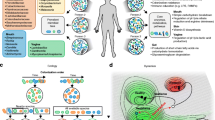Abstract
We have developed a new approach for the estimation of bacterial proportional compositions in microbiota based on terminal restriction length polymorphism (T-RFLP) data and a Monte Carlo algorithm. This program estimates proportional compositions by minimizing distances between peak values and the relative abundance of each group, containing several species, estimated from peak areas of capillary electrophoresis for T-RFLP analysis. Oral bacteria in 36 saliva samples obtained from three individuals were analyzed using the program. Upon comparison, the estimated proportional composition obtained from one of the samples matched that from a clone library. Additionally, comparisons among the bacterial proportional compositions of saliva samples obtained from three individuals four times per day for 3 days revealed that the types of microbiota present in each individual did not change within each 24-h time period and were distinguishable from those in other individuals.



Similar content being viewed by others
References
Altschul SF, Gish W, Miller W, Myers EW, Lipman DJ (1990) Basic local alignment search tool. J Mol Biol 215:403–410
Cole JR, Chai B, Farris RJ, Wang Q, Kulam-Syed-Mohideen AS, McGarrell DM, Bandela AM, Cardenas E, Garrity GM, Tiedje JM (2007) The ribosomal database project (RDP-II): introducing myRDP space and quality controlled public data. Nucleic Acids Res 35(Database issue):D169–D172
DeLong EF, Pace NR (2001) Environmental diversity of bacteria and archaea. Syst Biol 50:470–478
Kumar PS, Griffen AL, Moeschberger ML, Leys EJ (2005) Identification of candidate periodontal pathogens and beneficial species by quantitative 16S clonal analysis. J Clin Microbiol 43:3944–3955
Liu WT, Marsh TL, Cheng H, Forney LJ (1997) Characterization of microbial diversity by determining terminal restriction fragment length polymorphisms of genes encoding 16s rRNA. Appl Environ Microbiol 63:4516–4522
Marsh TL (2005) Culture-independent microbial community analysis with terminal restriction fragment length polymorphism. Methods Enzymol 397:308–329
Muyzer G, De Waal EC, Uitterlinden AG (1993) Profiling of complex microbial populations by denaturing gradient gel electrophoresis analysis of polymerase chain reaction-amplified genes coding for 16S rRNA. Appl Environ Microbiol 59:695–700
Nakano Y, Takeshita T, Yamashita Y (2006) TRFMA: a web-based tool for terminal restriction fragment length polymorphism analysis based on molecular weight. Bioinformatics 22:1788–1789
Nakano Y, Takeshita T, Kamio N, Shiota S, Shibata Y, Yasui M, Yamashita Y (2008) Development and application of a T-RFLP data analysis method using correlation coefficient matrices. J Microbiol Methods 75:501–505
R Development Core Team (2006) R: a language and environment for statistical computing. R Foundation for Statistical Computing, Vienna, Austria
Rosenberg M (1996) Clinical assessment of bad breath: current concepts. J Am Dent Assoc 127:475–482
Shibata Y, Ozaki K, Seki M, Kawato T, Tanaka H, Nakano Y, Yamashita Y (2003) Analysis of loci required for determination of serotype antigenicity in Streptococcus mutans and its clinical utilization. J Clin Microbiol 41:4107–4112
Siqueira JF, Rôças IN, Souto R, Uzeda M, Colombo AP (2000) Checkerboard DNA–DNA hybridization analysis of endodontic infections. Oral Surg Oral Med Oral Pathol Oral Radiol Endo 89:744–748
Takeshita T, Nakano Y, Yamashita Y (2007) Improved accuracy in terminal restriction fragment length polymorphism phylogenetic analysis using a novel internal size standard definition. Oral Microbiol Immunol 22:419–428
Takeshita T, Nakano Y, Kumagai T, Yasui M, Kamio N, Shibata Y, Shiota S, Yamashita Y (2009) The ecological proportion of indigenous bacterial populations in saliva is correlated with oral health status. ISME J 3:65–78
Acknowledgements
This work was supported in part by Grants-in-Aid for Scientific Research 21592652 (Y.N.), 19390541 (Y.Y.), and 21659486 (Y.Y.) from the Ministry of Education, Culture, Sports, Science and Technology of Japan.
Author information
Authors and Affiliations
Corresponding author
Rights and permissions
About this article
Cite this article
Nakano, Y., Takeshita, T., Yasui, M. et al. Prediction of Plausible Bacterial Composition Based on Terminal Restriction Fragment Length Polymorphisms using a Monte Carlo Method. Microb Ecol 60, 364–372 (2010). https://doi.org/10.1007/s00248-010-9703-9
Received:
Accepted:
Published:
Issue Date:
DOI: https://doi.org/10.1007/s00248-010-9703-9




